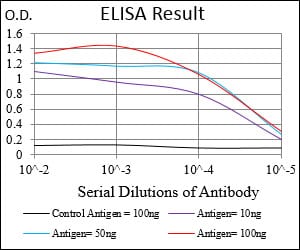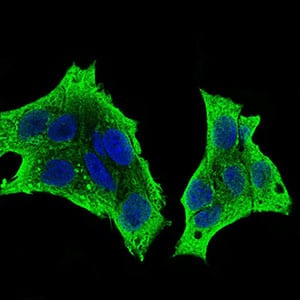



| WB | 1/200-1/1000 | Human,Mouse,Rat |
| IF | 咨询技术 | Human,Mouse,Rat |
| IHC | 1/15-1/50 | Human,Mouse,Rat |
| ICC | 技术咨询 | Human,Mouse,Rat |
| FCM | 咨询技术 | Human,Mouse,Rat |
| Elisa | 1/1000-1/2000 | Human,Mouse,Rat |
| Aliases | FMS; CSFR; FIM2; HDLS; C-FMS; CD115; CSF-1R; M-CSF-R |
| Entrez GeneID | 1436 |
| clone | 6B9B9 |
| WB Predicted band size | 108kDa |
| Host/Isotype | Mouse IgG2b |
| Antibody Type | Primary antibody |
| Storage | Store at 4°C short term. Aliquot and store at -20°C long term. Avoid freeze/thaw cycles. |
| Species Reactivity | Human |
| Immunogen | Purified recombinant fragment of human CSF1R (AA: 344-497) expressed in E. Coli. |
| Formulation | Purified antibody in PBS with 0.05% sodium azide |
+ +
以下是关于O-GlcNAcase(OGA)抗体的3篇参考文献及其摘要内容:
---
1. **文献名称**:*A role for O-GlcNAcylation in the cellular stress response*
**作者**:Dona C. Love, John A. Hanover
**摘要**:该研究探讨了O-GlcNAc修饰(由OGA调控)在细胞应激反应中的作用。作者通过Western blot和免疫荧光技术,利用特异性OGA抗体证明,抑制OGA活性可增强O-GlcNAc水平,进而调控热休克蛋白表达,保护细胞免受氧化应激损伤。
---
2. **文献名称**:*O-GlcNAcase is essential for embryonic development and maintenance of genomic stability*
**作者**:Gerald W. Hart et al.
**摘要**:研究利用基因敲除小鼠模型和OGA特异性抗体,揭示OGA在胚胎发育中的关键作用。实验表明,OGA缺失导致O-GlcNAc修饰异常积累,引发DNA损伤反应和胚胎致死,强调了OGA在维持基因组稳定性中的功能。
---
3. **文献名称**:*Characterization of O-GlcNAcase inhibitors and antibodies for studying O-GlcNAc dynamics*
**作者**:Suzanne R. Trinidad et al.
**摘要**:本文系统评估了多种OGA抗体的特异性和应用场景,比较了不同抗体在免疫沉淀、免疫组化中的表现。研究发现,某些抗体(如CTD110.6)在检测OGA时存在交叉反应,需结合抑制剂验证结果,为O-GlcNAc动态研究提供方法学参考。
---
这些文献涵盖了OGA抗体的应用场景(如应激、发育)、技术验证(抗体特异性分析)及生物学功能研究,可为相关实验设计提供依据。
O-GlcNAcase (OGA) is a glycoside hydrolase responsible for the removal of O-linked β-N-acetylglucosamine (O-GlcNAc) post-translational modifications from proteins. This dynamic modification, regulated by OGA and its opposing enzyme O-GlcNAc transferase (OGT), plays critical roles in cellular processes such as nutrient sensing, transcriptional regulation, and stress response. Dysregulation of O-GlcNAc cycling has been implicated in metabolic disorders, neurodegenerative diseases (e.g., Alzheimer’s), and cancer, driving interest in OGA as a therapeutic target.
OGA-specific antibodies are essential tools for studying its expression, localization, and activity. They enable detection via techniques like Western blotting, immunohistochemistry, and immunofluorescence, aiding in the exploration of OGA's tissue distribution and disease-associated alterations. Additionally, these antibodies support research on OGA inhibitors, which are being investigated for modulating O-GlcNAc levels in pathological conditions. Recent studies also highlight OGA's involvement in epigenetic regulation and immune function, expanding its biomedical relevance. However, antibody specificity remains a challenge due to structural similarities among glycosidases, necessitating rigorous validation. Continued development of high-affinity, isoform-selective OGA antibodies is crucial for advancing both basic research and clinical applications targeting O-GlcNAc signaling.
×